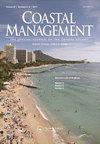Bivalve Shellfish Aquaculture in the National Estuarine Research Reserves: Assessing Current Activities, Relevant Policy, and Engagement Approaches
IF 1.9
4区 环境科学与生态学
Q4 ENVIRONMENTAL SCIENCES
引用次数: 0
Abstract
Abstract Expansion of shellfish aquaculture in the U.S. is currently being promoted for its demonstrated potential as an environmentally friendly and sustainable food production system. The National Estuarine Research Reserve System (NERRS), through its network of protected estuarine sites and research, education, and interpretation mandates, may provide an effective means for enhancing public awareness and management of shellfish aquaculture within the nation’s estuarine areas. However, the NERRS’s role regarding the presence of aquaculture within Reserve boundaries, for research or non-research purposes, is not broadly understood by NERRS stakeholders. The goals of this study were to broadly review and highlight the current activities, regulatory framework, and engagement approaches to aquaculture within the NERRS, and more specifically, to focus on the suitability and role(s) the NERRS may choose to seek or strengthen with respect to shellfish aquaculture. To accomplish this, a survey questionnaire was disseminated within the NERRS community. Twelve of the 29 Reserves within the NERRS held some type of aquaculture activity, while 17 Reserves believed their Reserve was suitable or potentially suitable for shellfish aquaculture. Reserve suitability was driven by a range of factors, including: water quality, NERRS regulations, character of Reserve land-managing entities, scope of protected areas, and preexisting or historical shellfish aquaculture and/or wild harvest activities. Overall, the Reserves’ approach to shellfish aquaculture was locally focused, but with patterns that reflected a regional influence. Additionally, Reserves displayed key roles as coordinating entities and a trusted source of science. Particularly with establishing commercial aquaculture, it is critical to couple the goals of an aquaculture activity with the net positive and negative impacts to a specific geographic area. We recommend that the NERRS would benefit from developing best management practices for approaching shellfish aquaculture within Reserve boundaries, and educating and engaging with shellfish aquaculture stakeholders. One approach might be to develop a decision-support model for approaching and allowing each use of aquaculture (research, restoration, conservation, recreation, and commercial), in collaboration with regulatory agencies and other stakeholders.国家河口研究保护区的双壳贝类水产养殖:评估当前活动,相关政策和参与方法
摘要目前,美国正在推动贝类养殖的扩张,因为它已被证明是一种环保和可持续的食品生产系统。国家河口研究保护区系统(NERS)通过其受保护的河口遗址网络以及研究、教育和解释授权,可以为提高公众对国家河口地区贝类养殖的认识和管理提供有效手段。然而,NERRS的利益相关者并不广泛理解NERRS在保护区边界内水产养殖的作用,无论是出于研究还是非研究目的。本研究的目的是广泛审查和强调国家渔业资源监管系统内当前的水产养殖活动、监管框架和参与方法,更具体地说,重点关注国家渔业资源管理系统在贝类水产养殖方面可能选择寻求或加强的适宜性和作用。为了做到这一点,在NERS社区内分发了一份调查问卷。NERRS内的29个保护区中有12个拥有某种类型的水产养殖活动,而17个保护区认为其保护区适合或可能适合贝类水产养殖。保护区的适宜性是由一系列因素驱动的,包括:水质、NERS法规、保护区土地管理实体的性质、保护区的范围,以及先前存在或历史上的贝类养殖和/或野生捕捞活动。总的来说,保护区的贝类养殖方法以当地为重点,但模式反映了地区影响。此外,保护区作为协调实体和可靠的科学来源发挥了关键作用。特别是在建立商业水产养殖的情况下,将水产养殖活动的目标与对特定地理区域的净积极和消极影响结合起来至关重要。我们建议,NERS将受益于制定最佳管理实践,以处理保护区边界内的贝类养殖,并教育和参与贝类养殖利益相关者。一种方法可能是与监管机构和其他利益相关者合作,开发一个决策支持模型,以接近并允许水产养殖的每一种用途(研究、恢复、保护、娱乐和商业)。
本文章由计算机程序翻译,如有差异,请以英文原文为准。
求助全文
约1分钟内获得全文
求助全文
来源期刊

Coastal Management
环境科学-环境科学
CiteScore
6.00
自引率
0.00%
发文量
24
审稿时长
>36 weeks
期刊介绍:
Coastal Management is an international peer-reviewed, applied research journal dedicated to exploring the technical, applied ecological, legal, political, social, and policy issues relating to the use of coastal and ocean resources and environments on a global scale. The journal presents timely information on management tools and techniques as well as recent findings from research and analysis that bear directly on management and policy. Findings must be grounded in the current peer reviewed literature and relevant studies. Articles must contain a clear and relevant management component. Preference is given to studies of interest to an international readership, but case studies are accepted if conclusions are derived from acceptable evaluative methods, reference to comparable cases, and related to peer reviewed studies.
 求助内容:
求助内容: 应助结果提醒方式:
应助结果提醒方式:


